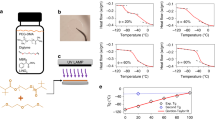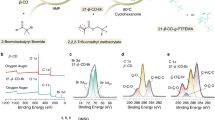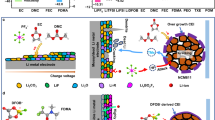Abstract
Ionically conducting polymer membranes (polymer electrolytes) might enhance lithium-battery technology by replacing the liquid electrolyte currently in use and thereby enabling the fabrication of flexible, compact, laminated solid-state structures free from leaks and available in varied geometries1. Polymer electrolytes explored for these purposes are commonly complexes of a lithium salt (LiX) with a high-molecular-weight polymer such as polyethylene oxide (PEO). But PEO tends to crystallize below 60 °C, whereas fast ion transport is a characteristic of the amorphous phase. So the conductivity of PEO–LiX electrolytes reaches practically useful values (of about 10−4 S cm−1) only at temperatures of 60–80 °C. The most common approach for lowering the operational temperature has been to add liquid plasticizers, but this promotes deterioration of the electrolyte's mechanical properties and increases its reactivity towards the lithium metal anode. Here we show that nanometre-sized ceramic powders can perform as solid plasticizers for PEO, kinetically inhibiting crystallization on annealing from the amorphous state above 60 °C. We demonstrate conductivities of around 10−4 S cm−1 at 50 °C and 10−5 S cm−1 at 30 °C in a PEO–LiClO4 mixture containing powders of TiO2 and Al2O3 with particle sizes of 5.8–13 nm. Further optimization might lead to practical solid-state polymer electrolytes for lithium batteries.
This is a preview of subscription content, access via your institution
Access options
Subscribe to this journal
Receive 51 print issues and online access
$199.00 per year
only $3.90 per issue
Buy this article
- Purchase on Springer Link
- Instant access to full article PDF
Prices may be subject to local taxes which are calculated during checkout


Similar content being viewed by others
References
Scrosati, B. Lithium batteries. Chim. Ind. (Milan) 79, 463–471 (1997).
Lightfoot, P., Metha, M. A. & Bruce, P. G. Crystal structure of the polymer electrolyte poly(ethylene oxide)3:LiCF3. Science 262, 883–885 (1993).
Vincent, C. A. & Scrosati, B. C. H. Modern Batteries. An Introduction to Electrochemical Power Sources 2nd edn (Arnold, London, (1997)).
Weston, J. E. & Steele, B. C. H. Effects of inert fillers on the mechanical and electrochemical properties on lithium salt-poly(ethylene oxide) polymer electrolytes. Solid State Ionics 7, 75–79 (1982).
Croce, F. & Scrosati, B. Interfacial phenomena in polymer electrolyte cells: lithium passivation and cyclability. J. Power Sources 43, 9–19 (1993).
Borghini, M. C., Mastragostino, M., Passerini, S. & Scrosati, B. Electrochemical properties of polyethylene oxide-Li[(CF3SO2)2N] — gamma-LiAlO2composite polymer electrolytes. J. Electrochem. Soc. 142, 2118–2121 (1995).
Capuano, F., Croce, F. & Scrosati, B. Composite polymer electrolytes. US Patent No. 5,576,115 (1996).
Croce, F., Bonino, F., Panero, S. & Scrosati, B. Properties of mixed polymer and crystalline ionic conductors. Phil. Mag. B 59, 161–168 (1989).
Capuano, F., Croce, F. & Scrosati, B. Composite polymer electrolytes. J. Electrochem. Soc. 52, 1918–1922 (1991).
Kumer, B. & Scanlon, Y. G. Polymer ceramic composite electrolytes. J. Power Sources 52, 261–268 (1994).
Croce, F., Scrosati, B. & Mariotto, G. Electrochemical and spectroscopic study of the transport properties of composite polymer electrolytes. Chem. Mater. 4, 1134–1136 (1992).
Wieczorek, W., Florjancyk, Z. & Stevens, J. R. Composite polyether based electrolytes. Electrochim. Acta 40, 2251–2258 (1995).
Przyluski, J., Siekierski, M. & Wieczorek, W. Effective medium theory in studies of conductivity of composite polymeric electrolytes. Electrochim. Acta 40, 2101–2108 (1995).
Kumer, B. paper presented at 5th Workshop for Battery Exploration Development, US Navy, 30 June–3 July, Burlington, VT (1997).
Gray, F. M. Solid Polymer Electrolytes-Fundamentals and Technical Applications (VCH, Wenheim, (1991)).
Evans, J., Vincent, C. A. & Bruce, P. G. Electrochemical measurements of transference numbers in polymer electrolytes. Polymer 28, 2325–2330 (1987).
Abraham, K. M., Jiang, Z. & Carroll, B. Highly conductive PEO-like polymer electrolytes. Chem. Mater. 9, 1978–1988 (1997).
Scrosati, B. Challenge of portable power. Nature 373, 557–558 (1995).
Croce, F. & Scrosati, B. Composite polymer ionics: advanced electrolyte materials for thin-film batteries. Polym. Adv. Techn. 4, 198–204 (1993).
Acknowledgements
We thank M. Musei (CISE Laboratory, Milan) for providing samples of TiO2 nanopowders.
Author information
Authors and Affiliations
Corresponding author
Rights and permissions
About this article
Cite this article
Croce, F., Appetecchi, G., Persi, L. et al. Nanocomposite polymer electrolytes for lithium batteries. Nature 394, 456–458 (1998). https://doi.org/10.1038/28818
Received:
Accepted:
Issue Date:
DOI: https://doi.org/10.1038/28818
This article is cited by
-
From Liquid to Solid-State Lithium Metal Batteries: Fundamental Issues and Recent Developments
Nano-Micro Letters (2024)
-
The Promise of 3D Printed Solid Polymer Electrolytes for Developing Sustainable Batteries: A Techno-Commercial Perspective
International Journal of Precision Engineering and Manufacturing-Green Technology (2024)
-
Enhancing optical, structural, thermal, electrical properties, and antibacterial activity in chitosan/polyvinyl alcohol blend with ZnO nanorods: polymer nanocomposites for optoelectronics and food/medical packaging applications
Polymer Bulletin (2024)
-
Solid electrolyte membranes with Al2O3 nanofiller for fully solid-state Li-ion cells
Polymer Bulletin (2024)
-
Polyethylene Oxide-Based Composite Solid Electrolytes for Lithium Batteries: Current Progress, Low-Temperature and High-Voltage Limitations, and Prospects
Electrochemical Energy Reviews (2024)
Comments
By submitting a comment you agree to abide by our Terms and Community Guidelines. If you find something abusive or that does not comply with our terms or guidelines please flag it as inappropriate.



